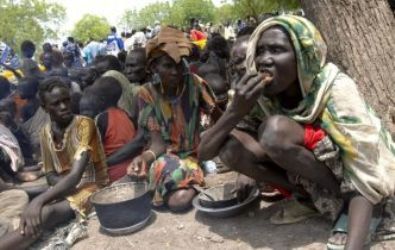Over 4 million South Sudanese food insecure, says UN
March 2, 2013 (JUBA) – At least 4.1 million people in South Sudan are likely to be food insecure this year, a new report released by the United Nations Food and Agricultural Organization (FAO) and World Food Programme (WFP) reveals.

Food production, according to the report, increased by over 35% between 2011 and 2012, due to good rains, improved cultivation practices and with more areas under cultivation.
However, in addition to the 40% of the population already at risk of food insecurity, the report anticipates more than one million people are likely to be severely affected.
Chris Nikoi, WFP Country Director, said South Sudan, despite the country’s tremendous agricultural potential, and the improved harvest estimate, it’s overall food security situation remains very precarious.
“We must redouble efforts to improve the livelihoods of the poorest and most vulnerable South Sudanese, and ensure they can produce their own food or can afford to buy food to meet their needs, and are more resilient to shocks,” Nikoi said in a statement.
This year’s assessment, officials say, is an improvement in the food security situation in a country, where more than 4.7 million people were projected to be at risk of facing hunger last year alone.
“The CFSAM is our best estimate, but it’s imprecise,” Sue Lautze, FAO’s Head of Office in South Sudan.
“What we need is a comprehensive agricultural census covering fish, livestock and crops. This would provide a more accurate baseline against which annual production can be more precisely measured”, she added.
In addition, with the increasing high food prices in the country, the report says a significant amount of food supply will be required in parts of the country, where commercial supply is equally poor, with a “cereal gap” of 371,000 metric tons.
Another 2.8 million people, WFP says, remain in dire need for food and nutritional assistance, including food insecure rural families, vulnerable children, internally displaced people (IDPs), refugees and returnees.
“This will require about 224,000 tons of food of various kinds,” it notes.
The report, also extended to Sudan Tribune, further warns that increased conflict and economic instability could increase the number of people requiring food assistance by more than a million.
“Insecurity remains a major constraint to optimising South Sudan’s agricultural potential. Incidents of armed cattle rustling, conflicts between and among communities, and the activities of militia groups continue to inhibit farmers in affected areas,” it says.
Nearly $1.2bn has been allocated as Consolidated Appeal (CAP) for South Sudan, which aims to reduce suffering, provide protection, and boost the resilience of the most vulnerable people.
(ST)
